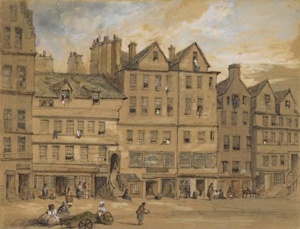In the eyes of an unaware passer-by, the tall façade of Gladstone’s Land might go unnoticed, squeezed between the colourful and noisy attractions of the Royal Mile. However, don’t let this mislead you! In fact, this building hides a multitude of artistic, architectural and historical gems, which give a pertinent insight into the history of Edinburgh during the 17th century.
Although the house, once owned by the rich merchant Thomas Gladstone, is today part of Old and New Town of Edinburgh UNESCO World Heritage Site and is owned by the National Trust for Scotland since 1934. The discovery of its cultural patrimony was a matter of luck. The building was spared from demolition in the 1890s, primarily for its beautiful 17th century Palladian arches and because the house was one of the oldest surviving buildings in the Royal Mile. However, to great surprise of the Trust, a cultural heritage was discovered inside the building.

The central artistic attractions of the building are three incredible Renaissance hand-painted ceilings. Their decorations offer different interpretations. On one hand, they might be a visual proof of the gradual rather than immediate process, which the Reformation represents for the Scottish artistic production. In fact, the ceilings are rich in Catholic symbols, 50 years after the Scottish Reformation had already taken place. On the other hand, the exotic theme of such decorations could be meant to impress upon people the wealth of the landlord and of the tenants who rented the property.
Following the life of the different tenants, it is possible to glimpse at Edinburgh’s culture and society during the 17th century. You could discover, for example, that oysters were so abundant that they were considered a humble food only eaten by servants and poor people. Or that by 1684 Old Town buildings could reach heights of up to 14 stories being forerunners of modern skyscrapers. My favourite discovery was that beer was drunk instead of water (yes, it was even given to kids) allegedly because it was safer than the latter. Might this trace the historical origin of modern pub culture?
The great strength of Gladstone’s Land is the attention put into maintaining the visiting experience so historically relevant. Today, where 400 years ago stood the shop of John Riddoch, we can find the gift-shop selling- no longer exotic spices- but traditional Scottish and British products. By the end of March, the building will be a self-guided attraction. However, for the same price (£5 adults, free for members of the National Trust for Scotland) I would recommend making use of the guides’ expertise. With a ratio of 10:1, the staff members of Gladstone’s Land are mostly enthusiast volunteers who will guide you back in time to learn about the 17th century Scottish lifestyle or the history of witch-hunting in Edinburgh. Another great chance to visit Gladstone’s Land are the lecture series hosted by the building or the incoming living history day in collaboration with the Scottish Battlefields Trust on February the 2nd.
- Backbone @ Underbelly Bristo Square - 23rd August 2019
- Goliath in the Water @ Assembly Checkpoint - 22nd August 2019
